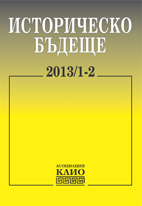Войнушката институция и селищата с войнушко население в ливата (санджака) София през ХV–ХVI век
The Voynuk Institution and the Settlements with Voynuk Population in Sofia Liva (Sandžak) in the 15th – 16th C
Author(s): Krastyo YordanovSubject(s): History
Published by: Асоциация Клио
Keywords: Sofia sandzhak, kaza Shehirkyoy, kaza Berkovitsa, Znepole, voynuks, voynuk registers, villages, seraskers, lagators
Summary/Abstract: New data on the basis of an unpublished voynuk register about 336 settlements from the kazas Sofia, Shehirkyoy (Pirot) and Berkovitsa from the Sofia sandzhak, in which 2275 voynuks enrolled in service in the State Stables were registered during the first half of the 16th century, is presented in the article. The information in the register shows that since voynuks lived in scattered groups in many settlements, the settlements in which no more than 10 people were registered as serving in the voynuk corps prevailed. An exception were some settlements from the Znepole nahiya, where the voynuks and zevaid-voynuks represented the whole population or a considerable percent of it. The presented data shows that during the first half of the 16th century the Sofia sandzhak was an original center of the voynuk institution, which is suggested by the impressing organizational solidity of the voynuk low command in the region, for which three seraskers / cheribashiyas (military leaders) and 16 lagators were in charge in 1528/29. But the voynuk register from 1528/29 also shows that it was a crucial stage of the existence of the voynuk corps, when most of the dzhebelyu voynuks (military obliged population) in Roumelia including the 764 dzhebeliyas until recently from Znepole (Tran region) and Berkovitsa region, were turned from actual warriors into military subsidiary unit serving the state stables. The new data from the first half of the 16th century is compared with the information in the long known register of voynuk patrimony from 1606. The comparison shows that during the second half of the 16th century and the beginning of the 17th century the first signs that the need of the militarized divisions of Christian population decreases can be noted. The cancellation of the service for a great number of voynuks in Sofia region and the desolation of a lot of their work patrimonies is a proof of that.
Journal: Историческо бъдеще
- Issue Year: 2013
- Issue No: 1-2
- Page Range: 108-165
- Page Count: 58
- Language: Bulgarian
- Content File-PDF

